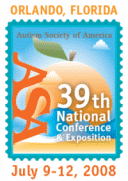 |
The ASA's 39th National Conference on Autism Spectrum Disorders of ASAThe Westin Kierland Resort & Spa, Scottsdale, AZ |
| For a complete author index with session numbers, please click here | |
Friday, July 11, 2008
Florida Exhibit Hall A (Gaylord Palms Resort & Convention Center)
5
Best Practices in Assessment: Choosing the Right Tools for the Job
Implementing effective assessment for young children with autism can be challenging for teams for a variety of reasons. First, children with autism often have unusual developmental profiles and exhibit splinter skills making assessment frustrating for children and confusing for adults. Team challenges include time and availability in addition to a need for a high level of expertise from various disciplines. Many assessments require the assistance of specialists to assess specific skill sets such as motor skills and speech, and specialists are not always available in school settings. For example, an occupational therapist may be available to teams for only two hours a week, during which time they are busy providing individual consultation to children. Assessing children with autism can also be a challenge because traditional assessments may bias results. Specifically, many assessments require the ability to verbalize, work rapidly, or cope with transitions. Finding an assessment that has been developed or tested on children with autism is often a difficult task.
While assessing children with autism can be challenging, teams should address the challenge by integrating what they know about effective assessment with what they know about children with autism. For example, it is important to always assess multiple areas of functioning including intellectual and communicative skills, behavior presentation, and functional adjustment. Choosing an assessment with a developmental perspective is critical because children with autism often have unusual developmental profiles. It is important to view assessment results within the context of overall developmental levels. Because children with autism have such variability within their skill sets, it is imperative to carefully document their unique strengths and weaknesses. Teams should be careful not to generalize from an isolated splinter skill because it may not be representative of a child’s more typical abilities.
Children with autism typically display varied behavior across settings which means that observations across environments is helpful for obtaining a true picture of a child’s functioning. Assessment results should be viewed in the broader context of a child’s daily functioning and response to real life demands (i.e. authentic assessment in the child’s natural environments). Finally, behavior difficulties are a necessary consideration during the assessment process to determine whether the child was unable to perform a skill or if it was a behavior issue.
The proposed poster will outline the concepts of effective authentic assessment for children with autism. The poster will provide examples of assessments that can be used for this population while adhering to principles of best practice. The Assessment, Evaluation, and Programming System (AEPS) is one example of an assessment that can be used for children with autism. The AEPS is a criterion-referenced, curriculum-based assessment that directly links assessment information to meaningful and functional instructional objectives. The AEPS assessment allows for modifications and adaptations to the test items as well as encouraging authentic naturalistic observations and parent reports as the central means of data collection. The AEPS addresses imperative skill sets for children with autism including social, communication, and adaptive areas and enables administrators to account for behavior in the outcomes for each item. In addition, the AEPS promotes observing children across settings and time in order to illustrate an accurate picture of the child with a focus on developmental levels. Additional examples of effective assessments for young children with autism that will be outlined in the poster (not described in detail here) include the SCERTS (Social Communication Emotional Regulation Transactional Supports), ABAS II (Adaptive Behavior Assessment System), and ABLLS (Assessment of Basic Language and Learning Skills).
See more of Poster Sessions
See more of The ASA's 39th National Conference on Autism Spectrum Disorders